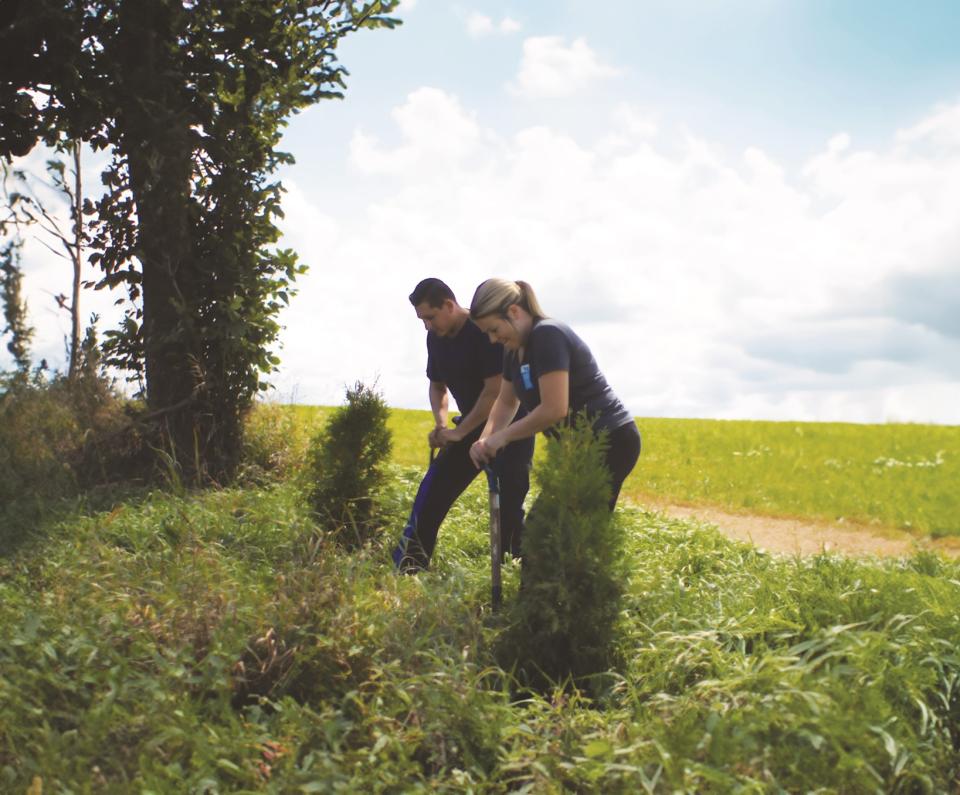Dairy Farmers of Canada (DFC) is committed to supporting dairy farmers as they work towards reaching net-zero greenhouse gas emissions by 2050. In early 2024, DFC partnered with Tree Canada to fund an initiative that encourages farmers across the country to plant trees on their land. As part of this partnership, Tree Canada is providing technical support and regional resources to assist participating dairy farmers as they plant tree seedlings that will thrive on their farms.
Planting trees on farms can help protect soil, improve air and water quality, and enhance wildlife habitat
Planting trees is one part of the dairy sector’s overall efforts to create a balance between emissions from farm operations and sequestering carbon in farmland. Increasing the number of trees on Canadian dairy farms will help capture carbon from the atmosphere, enhance surrounding biodiversity, provide wind breaks, and increase soil quality, among other benefits.
To qualify for the program, a dairy farm must have available a plantable area of 0.25 hectares. This surface provides ample space for at least 600 tree seedlings. The plantable area can be marginal agricultural lands, areas affected by natural disturbances like wildfires, windstorms or insect outbreaks, or areas where farmers want to enhance existing features which provide habitat for wildlife, such as woodlands, grasslands, or riparian (near water) areas. The land around the perimeters of fields is also an eligible space to plant trees that will serve as shelterbelts or windbreaks.

Seedlings will create windbreaks and diverse shelterbelts
In collaboration with the Upper Thames River Conservation Authority (UTRCA) in Southwestern Ontario, a combined total of 4,800 seedlings were planted along the perimeters of eight fields on four dairy farms, creating windbreaks and diverse shelterbelts.
“We were lucky to work with Tree Canada on these projects,” said Robert Davies, the Forestry and Restoration Supervisor at UTRCA. “With [their support], we are able to offer these landowners significant grants to reduce the overall cost of their project.”
Planting was completed in May 2024 with various tree species that thrive in the region, including white cedar, red cedar, white pine, sycamore, silver maple and red oak.
These species were selected based on the specific characteristics of the planting site, such as soil type, drainage, and regional climate. For windbreaks, it is common to plant coniferous trees that will provide a greater surface area to mitigate soil erosion caused by wind. Other trees and shrubs were added to enhance the benefits to wildlife and pollinators.
Dairy farmers Kaitland and Andrew were keen to raise their hand to plant trees on their farm in the Upper Thames River watershed. With Tree Canada, the couple has planted a total of 450 white cedar trees along the perimeter of a field where they grow crops, to help mitigate the effects of wind erosion.
As the trees grow around their field, Kaitland and Andrew can also expect to see more benefits from their new windbreak, including providing habitat for wildlife, better water absorption, and beautifying the landscape. The two farmers are excited about this initiative, saying, “We viewed this project as a long-term investment and solution that will benefit our farm for many years to come.”

--This article was adapted from a previous article by Dairy Farmers of Canada and Tree Canada.